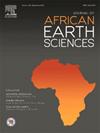In Ezzane火山场(阿尔及利亚Hoggar东部)及其神秘的圆形结构
IF 2.2
4区 地球科学
Q2 GEOSCIENCES, MULTIDISCIPLINARY
引用次数: 0
摘要
In Ezzane地区位于阿尔及利亚撒哈拉沙漠东部,靠近利比亚-尼日尔边界,以上新世晚期和更新世火山活动和一组直径4-9公里的非凡圆形构造为标志,位于由Tassili寒武系-奥陶系砂岩组成的基底上。这两种表现都是叠瓦状的,只能是次同时代的。在这项研究中,首先,我们确定了火山活动的日期和特征,其次,我们试图限制圆形结构的起源,这些结构是在该地区出于安全原因关闭之前访问的。两个玄武岩熔岩的K-Ar测年年龄分别为2.01±0.05 Ma(格拉西亚)和1.49±0.03 Ma(卡拉布里亚)。岩石学研究表明,大部分火山岩为玄武岩,由橄榄石和Al-Ti透辉石斑晶组成,地幔为异晶橄榄石和正辉石。火山喷发温度(1200 ~ 1300℃)和原始泥质岩浆温度(1500 ~ 1600℃,即深度120 ~ 150 km)、主要元素和微量元素以及Sr-Nd同位素均指向Murzuq克拉通(Murzuq火山省)西部岩石圈边缘的软流圈源。In Ezzane的反浮雕圆形构造嵌套,并与NNW-SSE对齐,每个构造都被东南偏南方向的下一个构造截断。在圆形构造外500米处,塔西利砂岩呈红色,被强烈的裂缝所切割,裂缝中充满了细粒的棕色物质和新形成的针状白色石英,并经常显示出厘米大小的白色囊泡。圆形构造的边缘由密集角化砂岩和暗脉组成,而中心部分则由松散的脉状暗脉网络横切而成。对热液角砾岩成分的显微观察、SEM图像、SEM- eds测定和激光icp - ms化学分析表明,大量流体在浅层深处快速移动,并导致加热砂岩的水力压裂,产生了主要由氧化铁组成的矿脉。讨论了可能诱发这些大型圆形结构的各种过程的可行性,即构造起伏,火成岩和伴生热液现象,陨石撞击坑,并有利于砂岩岩溶特征。本文章由计算机程序翻译,如有差异,请以英文原文为准。
The In Ezzane volcanic field (Eastern Hoggar, Algeria) and its enigmatic circular structures
The In Ezzane region, located in eastern Algerian Sahara, close to Libya – Niger border, is marked by late Pliocene and Pleistocene volcanism and by a remarkable group of circular structures, 4–9 km in diameter, situated on a basement composed of Tassili Cambrian-Ordovician sandstones. Both manifestations are imbricated and can only be subcontemporaneous. In this study, first, we date and characterize the volcanism and second, we try to constrain the origin of the circular structures that were visited just before the region closed for security reasons. Two basaltic lavas were dated at 2.01 ± 0.05 Ma (Gelasian) and at 1.49 ± 0.03 Ma (Calabrian) by K-Ar method. Petrographic investigations show that most volcanic rocks are basanites composed of olivine and Al-Ti diopside phenocrysts with xenocrystic mantle olivine and orthopyroxene. Temperatures of eruptions (1200–1300 °C) and of primary picritic magma (1500–1600 °C, i.e. a depth of 120–150 km), along with major and trace elements, and Sr-Nd isotopes all point to an asthenospheric source along the western lithospheric margin of the Murzuq craton (Murzuq volcanic province). The In Ezzane counter-relief circular structures are nested and NNW-SSE aligned, with each structure being truncated by the next one to the south-south-east. Up to 500 m outside circular structures, Tassili sandstones are reddened, dissected by intense fractures that are filled with fine-grained brown material and newly formed acicular white quartz, and often show white, cm-size, vesicles. The rims of the circular structures are composed of densely brecciated sandstones with dark veins, whereas the central parts are crosscut by a loose network of dyke-like dark veins. Microscopic observations, SEM imagery, SEM-EDS determinations and laser-ICP-MS chemical analyses of hydrothermal breccia components point to large masses of fluids having moved rapidly at shallow depths and having induced hydrofracturing of the heated sandstones with the generation of veins composed mostly of iron oxide. The viability of various processes that may have induced these large circular structures, i.e. tectonic reliefs, igneous and associated hydrothermal phenomena, meteorite impact craters, are discussed and favour sandstone karst features.
求助全文
通过发布文献求助,成功后即可免费获取论文全文。
去求助
来源期刊

Journal of African Earth Sciences
地学-地球科学综合
CiteScore
4.70
自引率
4.30%
发文量
240
审稿时长
12 months
期刊介绍:
The Journal of African Earth Sciences sees itself as the prime geological journal for all aspects of the Earth Sciences about the African plate. Papers dealing with peripheral areas are welcome if they demonstrate a tight link with Africa.
The Journal publishes high quality, peer-reviewed scientific papers. It is devoted primarily to research papers but short communications relating to new developments of broad interest, reviews and book reviews will also be considered. Papers must have international appeal and should present work of more regional than local significance and dealing with well identified and justified scientific questions. Specialised technical papers, analytical or exploration reports must be avoided. Papers on applied geology should preferably be linked to such core disciplines and must be addressed to a more general geoscientific audience.
 求助内容:
求助内容: 应助结果提醒方式:
应助结果提醒方式:


